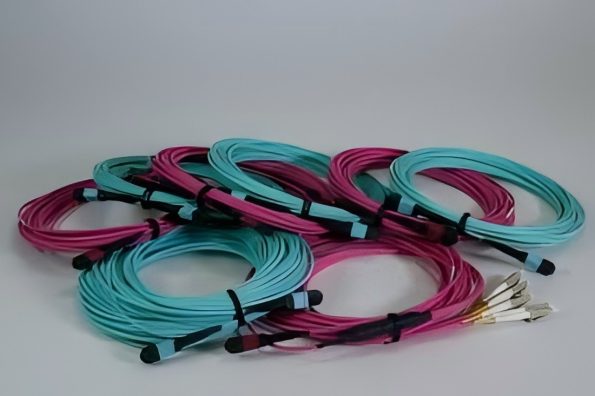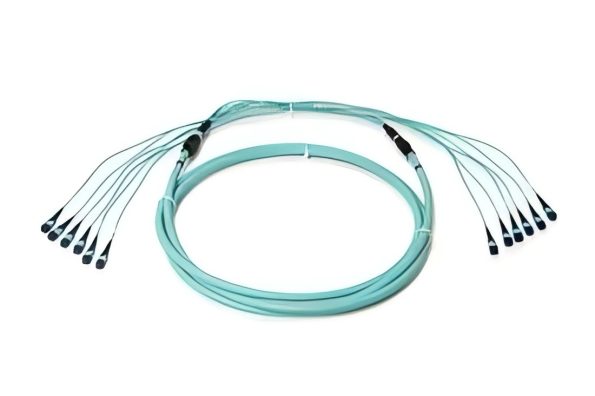In high-density network environments such as data centers, MTP trunk cables and MTP breakout cables are two essential types of fiber optic cables. Each serves a specific purpose and is designed to meet different networking needs, making it crucial to understand their differences, functions, and how to select the best one for your application.

What Are MTP Trunk Cables?
MTP trunk cables are high-capacity cables that connect multiple MTP connectors between two main fiber distribution points. Ideal for creating a backbone within a data center, connecting various racks, and simplifying network configurations, these cables typically come in 12-fiber or 24-fiber arrays, making them suitable for linking large, high-density networks.
Advantages of MTP Trunk Cables:
- Simplified Backbone: Trunk cables consolidate multiple fibers, reducing clutter and simplifying installation.
- High Capacity: With support for large fiber counts, these cables are perfect for creating high-performance backbones in data centers.
- Reduced Cable Congestion: By combining multiple fibers into one trunk, MTP trunk cables save space and improve airflow within racks.
Understanding MTP Breakout Cables
MTP breakout cables, also known as fanout cables, take one MTP connector and split it into multiple connectors, typically LC or SC connectors. These cables are used to connect high-density backbone cables to individual devices or distribution equipment. They work well for patching into different ports within a rack and facilitate connecting multiple devices to a single network point.

Benefits of MTP Breakout Cables:
- Direct Connectivity: Breakout cables offer direct connections from backbone cables to individual devices.
- Flexible Termination Options: With multiple connector types, they provide compatibility with various devices within the network.
- Great for Patch Panels: These cables are useful in situations where you need to connect one trunk cable to various patch panels or other equipment.
Key Differences Between MTP Trunk and Breakout Cables:
- Connection Purpose: MTP trunk cables are primarily used for high-capacity, point-to-point connections between distribution points in the backbone. MTP breakout cables, on the other hand, are designed for patching the trunk lines to individual devices or ports.
- Cable Structure: MTP trunk cables generally have identical MTP connectors on each end, while breakout cables have an MTP connector on one end and multiple LC or SC connectors on the other.
- Network Flexibility: Trunk cables are ideal for connecting racks or distribution points with high fiber counts, while breakout cables provide flexibility for connecting individual ports or devices.
Choosing Between MTP Trunk and MTP Breakout Cables:
- Assess Network Needs: If you need to connect two main distribution points or racks, MTP trunk cables are the best choice. For linking backbone cables to various ports or devices, MTP breakout cables provide greater flexibility.
- Determine Fiber Density: Consider how many fibers you need in your setup. For high-capacity applications, MTP trunk cables with 12, 24, or even 48 fibers will work well. If individual device connections are necessary, breakout cables offer flexibility with lower fiber counts.
- Evaluate Connector Compatibility: Ensure that the connector types match your equipment. MTP trunk cables usually have MTP-to-MTP connections, while breakout cables come with multiple connector types such as LC, SC, or MPO, depending on your network requirements.
- Future Scalability: If you anticipate expanding your network, MTP trunk cables are more scalable and easier to manage for high-density backbones. Breakout cables, however, offer adaptability for devices that require a specific connector type.
Best Practices for Installation and Use:
- Use Cable Management Systems: Both MTP trunk and breakout cables can be bulky, so cable management systems are crucial to maintain organization, prevent tangling, and optimize airflow.
- Maintain Polarity Standards: Always verify that the polarity of your MTP cables is correct to ensure data transmission follows the right direction across all connectors.
- Opt for Quality Materials: Choose high-quality cables to ensure signal integrity and minimize loss. Opting for well-manufactured MTP trunk and breakout cables will reduce potential network issues and improve longevity.
- Test Connections: Regular testing is essential to ensure that your connections are stable. Use fiber optic testers to confirm connectivity and reduce potential downtime.
Conclusion
Choosing between MTP trunk cables and MTP breakout cables depends on your network’s unique requirements, from the type of connection to desired scalability. MTP trunk cables are perfect for high-density backbones, while breakout cables provide direct, flexible connections to various ports or devices. By understanding their differences and using best practices, you can maximize the efficiency and flexibility of your fiber optic network.










